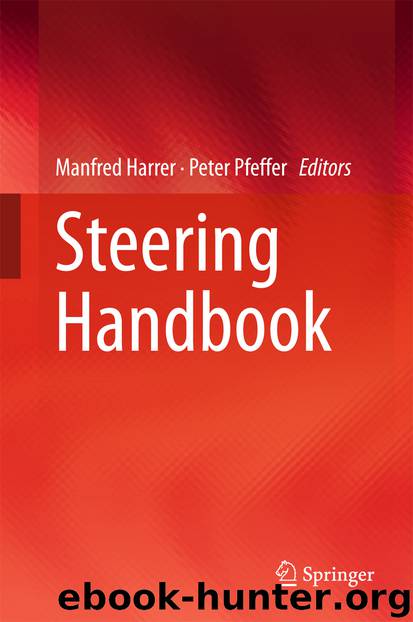Steering Handbook by Manfred Harrer & Peter Pfeffer

Author:Manfred Harrer & Peter Pfeffer
Language: eng
Format: epub
Publisher: Springer International Publishing, Cham
11.5.4.1 Size of the Rack Gain
The absolute limits for a rack gain are defined by the production process. Nevertheless, some limits are also due to the product development which defines the ‘constraints’. Early developments intended a least engagement angle of only 14°. These low angles have two shortcomings, though: One is a trend to wedge under load, i.e. the dovetailing of the pinion wedges together with the cogs of the rack, and this can cause excessive friction and high wear. The other is the higher accuracy of the cog flank surfaces required when the engagement angle is reduced, to achieve the same accuracy in vertical engaging. Concerning the rack gain and the cog engagement, the vertical portion has to be controllable in any case of deviation, because vertical deviations of the surfaces have a considerable impact. The horizontal component contributing to the rack gain is less important. Reducing the engagement angle entails higher requirements for accuracy but limits a further gain of the rack ratio. As a result, a lower limit of the normal engagement angle of 20° is used in reality.
The upper limit of the engagement angle is defined by the gear application. The helical pinion transfers forces on the cogs of the rack which can be divided into axial, transversal and vertical vectors. Accordingly, the general purpose in designing a rack-and-pinion steering is to maximise the axial component of this force, in particular for CGRs. Figure 11.22 compares pinion force vectors with low and high dovetailing engagement angles.
Fig. 11.22Pinion force vectors with low and high dovetailing engagement angle
Download
This site does not store any files on its server. We only index and link to content provided by other sites. Please contact the content providers to delete copyright contents if any and email us, we'll remove relevant links or contents immediately.
Algorithms of the Intelligent Web by Haralambos Marmanis;Dmitry Babenko(8518)
Test-Driven Development with Java by Alan Mellor(7346)
Data Augmentation with Python by Duc Haba(7246)
Principles of Data Fabric by Sonia Mezzetta(6993)
Learn Blender Simulations the Right Way by Stephen Pearson(6925)
Microservices with Spring Boot 3 and Spring Cloud by Magnus Larsson(6759)
RPA Solution Architect's Handbook by Sachin Sahgal(6164)
Hadoop in Practice by Alex Holmes(6028)
Jquery UI in Action : Master the concepts Of Jquery UI: A Step By Step Approach by ANMOL GOYAL(5869)
The Infinite Retina by Robert Scoble Irena Cronin(5865)
Big Data Analysis with Python by Ivan Marin(5692)
Life 3.0: Being Human in the Age of Artificial Intelligence by Tegmark Max(5397)
Pretrain Vision and Large Language Models in Python by Emily Webber(4650)
Infrastructure as Code for Beginners by Russ McKendrick(4435)
WordPress Plugin Development Cookbook by Yannick Lefebvre(4166)
Functional Programming in JavaScript by Mantyla Dan(4121)
The Age of Surveillance Capitalism by Shoshana Zuboff(4111)
Embracing Microservices Design by Ovais Mehboob Ahmed Khan Nabil Siddiqui and Timothy Oleson(3955)
Applied Machine Learning for Healthcare and Life Sciences Using AWS by Ujjwal Ratan(3928)
